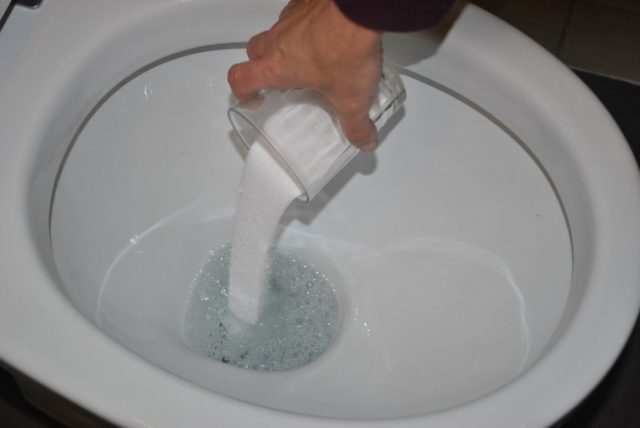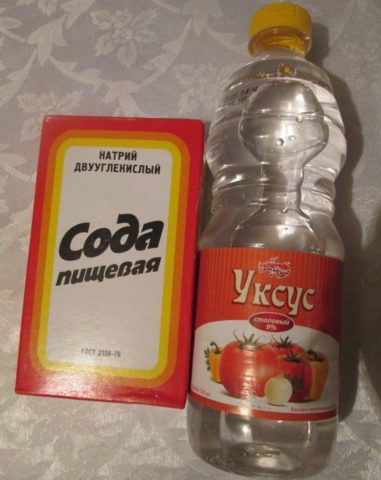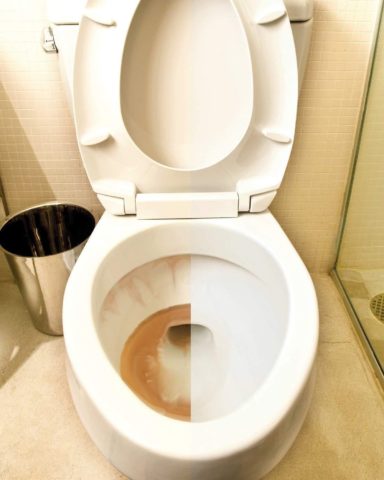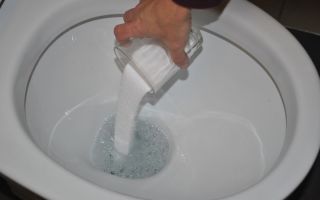Content
- 1 Features of cleaning the toilet with soda and vinegar
- 2 Pros and cons of baking soda and vinegar to clean the toilet
- 3 What kind of dirt does soda and vinegar help to clean the toilet
- 4 How to clean a toilet with baking soda and vinegar
- 5 Preventing the appearance of dirt in the toilet
- 6 Conclusion
- 7 Reviews on cleaning the toilet at home with vinegar and soda
The chemical industry offers a wide range of products used to eliminate problems with the duct in the sewage system, disinfect bathrooms, clean surfaces from rust, lime, and grease. The active substance, depending on the purpose, is acid and alkali. Cleaning the toilet with baking soda and vinegar will ultimately give no less effect, but with minimal costs.
Features of cleaning the toilet with soda and vinegar
The most visited place in a residential building is the toilet room, so constant cleaning of the toilet is necessary. The main accumulation of pathogenic microorganisms is under the rim. When washed off with water, bacteria can scatter a considerable distance. If the bathroom is small and even more so combined, bacteria can be found on toothbrushes, walls, doorknobs.
The main task is to prevent the accumulation and spread of the pathogen. Cleaning the ceramic or faience coating of the sanitary fixture should be done as often as possible. There is not always a chemical on hand or a person may have an allergic reaction to auxiliary components, for example, thickeners or fragrances. In this case, cleaning the toilet with acetic acid and baking soda is an optimal and no less effective option.
The effectiveness of cleaning with soda and vinegar is due to the reaction of alkali and acid. Baking soda (aka sodium bicarbonate) creates an alkaline environment when dissolved. Therefore, the substance is indispensable for removing fatty deposits or rust. But it is ineffective against calcareous compounds that settle on the walls of a sanitary-technical device, and minerals that get to the surface with urine and form a brown and very unaesthetic coating. In this case, acid is needed for cleaning, therefore vinegar in combination with sodium bicarbonate is a multifunctional tool.
You can clean the toilet not only with baking soda, but also with caustic soda, sodium bicarbonate - a substance with a more pronounced whitening effect and a chemical reaction with acid. The advantage of baking soda is that it not only cleans the surface of the toilet but also absorbs odor. Vinegar dissolves lime compounds, urinary stones and rust. The aggressive environment kills pathogens. These two inexpensive substances that are found in every home can quickly and effectively deal with the most difficult dirt during the cleaning process.
Pros and cons of baking soda and vinegar for toilet cleaning
The main problems with sanitation are related to the deposition of calcareous compounds on the surface. The reason in this case is water with a high lime content. A no less problem is a urinary calculus; it is quite difficult to get rid of it when it is neglected. Sewer pipes can eventually become clogged with fatty compounds that settle on the walls. The compressed sediments obstruct the full flow of water. To clean the toilet, vinegar can be replaced with citric acid, the reaction with soda and the effect of the product will be the same.
Pros of a folk remedy for cleaning plumbing:
- does not harm the material from which the corrugation and pipes are made;
- effectively combats all types of pollution;
- eliminates unpleasant odor;
- destroys the microbe;
- safe for humans;
- helps to eliminate blockage;
- effective against fatty deposits on sewer pipes;
- has bleaching properties.
If you clean the toilet properly with vinegar and soda in compliance with the technology and proportions, there are practically no downsides from using it.

What kind of dirt does soda and vinegar help to clean the toilet
The use of acid and sodium bicarbonate is effective not only when cleaning the surface, it will help to get rid of blockages in the drain passage and pipe. The main task is to determine the nature of the blockage and the place of localization. The reasons:
- remnants of building materials got into the sewer - this option is considered primarily during repair work;
- the drain passage was blocked by personal hygiene products, and if there is a small child in the house, the drain may be clogged with a children's toy, especially a soft one;
- fruit or spoiled food has fallen into the toilet;
- if there is one drain from the toilet and kitchen sink, it is possible that the pipe is clogged with compressed fat;
- a common cause is a garbage jam in the main sewer.
In the latter case, more effective measures will be needed than cleaning the toilet with soda and acid.
If the blockage is close, it can be pulled out of the pipe by hand, in case of failure, cleaning agents are used. During the reaction of acid and alkali, carbon dioxide is released, and it pushes the obstacle. You can break the blockage in the toilet with soda and acid as follows:
- Warm water (about 8-10 liters) is poured over a sanitary device and covered with a lid, left for two hours.
- If the blockage is loose, the water will gradually drain, the residues are removed completely.
- A plunger is used, with a stream of air it will help to move the blockage from its place.
- Then ½ pack of baking soda and 2 tbsp. Are poured into the toilet. vinegar heated to 400 C.
- The hole is tightly closed with a rag so that foam does not come to the surface, and carbon dioxide moves towards the obstacle in the pipe, and is left for 40 minutes.
- After that, they are again poured with warm water.

Cleaning the drain passages in case of severe blockage is carried out as follows:
- Remove liquid from the toilet.
- Mix in 1 liter of water 200 g of caustic soda and the same amount of acetic acid.
- Poured into the drain hole, close the passage.
- Leave for two hours.
Then the rest of the solution is washed off with warm water.
How to clean a toilet with baking soda and vinegar
The surface is cleaned with a different concentration of the agent, the choice depends on the degree and nature of the contamination. If the layer is thin, it will not be difficult to remove limescale from the toilet lining with vinegar and sodium bicarbonate. The method will also remove rust from the surface of the faience. After the procedure, there will be no foreign odors in the bathroom. The product can also be used to clean tiles, floors, wipe the outer surface of the toilet bowl and the door.
Sequence of action:
- The inside of the sanitary fixture is covered with a layer of soda.
- A damp sponge (hard part) is used to clean problem areas.
- Leave for 30 minutes.
- Then pour vinegar on top, the surface will begin to foam. In the course of the reaction, the places of the main limescale are intensively cleaned.
In case of severe pollution, baking soda is replaced with caustic, and vinegar - with 70% acetic acid, cleaning is carried out according to the same scheme. The procedure will remove plaque and disinfect the toilet.

Getting rid of urinary stones is a little more difficult, especially if the layer is not thin, cleaning the surface will take longer. The procedure is best done in the morning, when the apartment remains empty so that no one can use the bathroom, or at night. To clean the toilet from urinary stones, use soda, vinegar or essence and iodine. The last component will enhance the action of the acid. For old and dense plaque, sodium carbonate is used.
Cleaning technology:
- Water is completely removed from the bowl, the surface is wiped dry.
- 300 ml of acid is poured into a container, placed on the stove.
- The substance is heated to 400 C, the dishes are preliminarily covered.
- Remove from the stove, add 2 tbsp. l. sodium bicarbonate and 15 drops. iodine.
The mixture is covered with a sponge. On the most contaminated areas, put a napkin soaked in the product. Leave for at least eight hours. During this time, the plaque layer will completely move away from the coating. The surface is washed several times with soapy water and water is drained. If the initial cleaning was not effective enough, the event is repeated.
Preventing the appearance of dirt in the toilet
Cleaning the sanitary fixture is a necessary but unpleasant procedure. Frequent surface contamination with limescale, urinary calculus, rust can be avoided by observing preventive measures. Proper handling of plumbing will help preserve the whiteness and shine of the ceramic or earthenware coating, eliminate the formation of blockages in the drain pipe.
A few tips to get rid of the constant cleaning of your sanitary fixture:
- Eliminate the flow of water from the cistern - a constant stream leaves a mark on the surface.
- Avoid stagnation of dirty water - after each visit to the bathroom, use the drain button.
- Do not empty food waste - this will leave a greasy mark on the ceramic and cause blockages.
- Do not throw personal hygiene products into the bowl - an urn is used for these purposes.
- Constantly use a brush - to eliminate organic residues of the body's vital activity.
- The brush should not be dry - a mixture of water and cleaning agent is poured into the flask where it stands.
- Be sure to use water softening substances - they put special tablets in the drain tank or attach devices under the rim.
Preventive measures will save you from frequent surface cleaning and extend the life of the sanitary fixture.
Conclusion
Cleaning the toilet with baking soda and vinegar is no less effective than using chemicals. The acid removes all types of dirt deposited on the coating surface. The aggressive environment destroys pathogenic microorganisms. The substance gives the surface whiteness, eliminates unpleasant odor, breaks down fat deposits on pipes. The chemical reaction helps to clear the blockages. For more information on cleaning the toilet with baking soda and vinegar, see the video.

